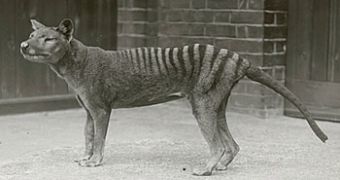This is the "Bigfoot" of Australia. But unlike the North American beast, this animal was real, exterminated by people: the Tasmanian tiger or thylacine. Now Australian researchers are on their way to investigate 50-year-old animal droppings in their search for solving one of the nation's great mysteries: is the Tasmanian tiger truly extinct?
The project will be led by zoologist Jeremy Austin, from Adelaide University's center for ancient DNA and will focus on scats discovered in the 1950s and 1960s, to see if they came from the Tasmanian tiger. The last known Tasmanian tiger died in captivity in 1936, in a zoo in the capital of Tasmania, Hobart, but since then unsubstantiated claims of sightings in the wild were announced regularly. But the last authentic sighting in the wild is one from 1918.
"If we find thylacine DNA from the 1950s scats it will be significant. It's a long shot that they were still around in the 1950s, but we can't rule it out at this stage." said Austin.
Hundreds of people said they have spotted the animal after 1936, but all searches did not come with any conclusive proof and the mystery of the beast got huge proportions, turning it into one of Australia's greatest scientific enigmas.
The droppings discovered in Tasmania by a thylacine expert are said to more likely come from a Tasmanian tiger than from the more common and smaller Tasmanian devil or quoll, thylacine's still living relatives.
The Tasmanian tiger was not a tiger at all (in Australia there are not any native cats, even if currently feral cats brought by Europeans are devastating its native fauna), but the world's largest marsupial carnivore. It looked like a large dog (hence its other name, the Marsupial Wolf) with stripes across its back (hence the name "tiger"), a stiff tail with a wide base (like in kangaroos or any other marsupial) and a large head.
A secretive, nocturnal animal, it was common in Tasmania before the European settlers' arrival in 1803. The Europeans feared the animal would attack their sheep and started an intensive campaign of extermination. The thylacine had no chance.

 14 DAY TRIAL //
14 DAY TRIAL //